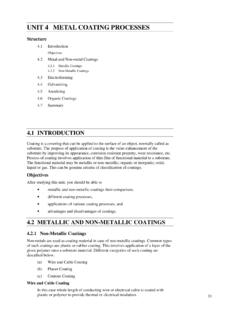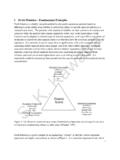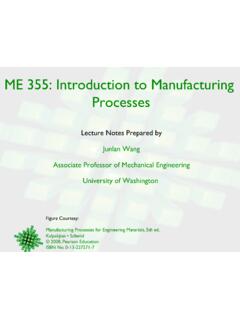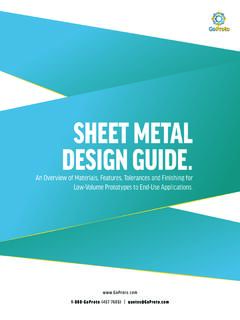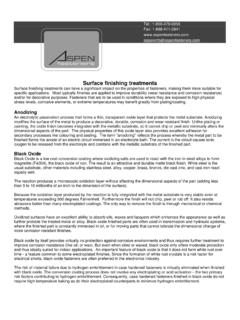Transcription of Guidance Manual for Implementing Total Toxic Organics (TTO ...
1 United States Permits Division September 1985. Environmental Protection Washington, DC 20460. Agency Water EPA Guidance Manual for Implementing Total Toxic Organics (TTO). Pretreatment Standards Guidance Manual FOR. Implementing Total Toxic . Organics PRETREATMENT STANDARDS. Prepared by Permits Division (EN-336). Office of Water Enforcement and Permits Office of Water September 1985. Environmental Protection Agency 401 M Street, Washington, 20460. TABLE OF CONTENTS. Chapter Page 1. INTRODUCTION. DEFINITION OF TTO .. 1-2. GENERAL ORGANIZATION .. 1-2. LIMITATIONS OF THIS Manual .. 1-3. 2. REPORTING REQUIREMENTS. BASELINE MONITORING REPORT .. 2-1. PROGRESS REPORTS .. 2-3. 90-DAY COMPLIANCE REPORT.
2 2-3. INDUSTRIAL USER SEMI-ANNUAL COMPLIANCE REPORT .. 2-3. 3. INDUSTRIAL CATEGORIES WITH TTO REQUIREMENTS. ELECTROPLATING AND metal FINISHING. TTO Limits .. 3-1. Alternative to TTO Monitoring .. 3-2. Sources of Toxic Organics .. 3-3. ELECTRICAL AND ELECTRONIC COMPONENTS. (PHASES I AND II). TTO Limits .. 3-4. Alternative to TTO Monitoring .. 3-5. Sources of Toxic Organics .. 3-6. COPPER FORMING. TTO Limits .. 3-6. Alternative to TTO Monitoring .. 3-8. Sources of Toxic Organics .. 3-8. ALUMINUM FORMING. TTO Limits .. 3-8. Alternative to TTO Monitoring .. 3-13. Sources of Toxic Organics .. 3-13. COIL coating . TTO Limit .. 3-14. Alternative to TTO Monitoring .. 3-16. Sources of Toxic Organics .
3 3-16. 4. Guidance FOR THE PREPARATION OF A Toxic ORGANIC. MANAGEMENT PLAN .. 4-1. 5. USE OF THE COMBINED WASTESTREAM FORMULA. DEFINITIONS .. 5-1. CWF CONDITIONS .. 5-1. CALCULATION OF ALTERNATIVE TTO LIMITS. USING THE CWF .. 5-2. TABLE OF CONTENTS (cont.). Chapter Page 6. REMOVAL CREDITS. REMOVAL CREDITS FOR TTO .. 6-1. REMOVAL CREDITS FOR TTO SURROGATE OR. INDICATOR POLLUTANTS .. 6-2. 7. TTO MONITORING Guidance . SAMPLING CONSIDERATIONS. Sampling Location .. 7-1. Sample Collection Techniques .. 7-2. Sample Volumes .. 7-3. Sample Equipment and Containers .. 7-12. Sample Preservation and Holding Times .. 7-13. Sample Type and Frequency for TTO. Monitoring .. 7-13. LABORATORY CONSIDERATIONS.
4 Analytical Procedures .. 7-20. Laboratory Quality Control .. 7-21. OIL AND GREASE MONITORING CONSIDERATIONS. Oil and Grease Sampling Considerations .. 7-21. Analytical Considerations for Oil and Grease .. 7-21. APPENDIX A: 40 CFR Section : Reporting Requirements for POTWs and Industrial Users .. A-1. APPENDIX B: Electroplating and metal Finishing Category: List of Toxic Organic Compounds Regulated as Components of Total Toxic Organics .. B-1. APPENDIX C: Electrical and Electronic Components Category: List of Toxic Organic Compounds Regulated as Components of Total Toxic Organics (By Subcategory) .. C-1. APPENDIX D: Example Toxic Organic Management Plan .. D-1. APPENDIX E: 40 CFR Section : Monitoring and Reporting Requirements.
5 E-1. ii 1. INTRODUCTION. The National Pretreatment Program establishes an overall strategy for controlling the introduction of nondomestic wastes to publicly owned treatment works (POTWs) in accordance with the overall objectives of the Clean Water Act. Sections 307(b) and (c) of the Act authorize the Environmental Protection Agency to develop national pretreatment standards for new and existing dischargers to POTWs. The Act made these pretreatment standards enforceable against dischargers to publicly owned treatment works. The General Pretreatment Regulations (40 CFR Part 403). established administrative mechanisms requiring certain POTWs to develop local pretreatment programs to enforce the general discharge prohibitions and specific Categorical Pretreatment Standards.
6 These Categorical Pretreatment Standards are designed to prevent the discharge of pollutants which pass through, interfere with, or are otherwise incompatible with the operation of the POTWs. The standards are technology-based for removal of Toxic pollutants and contain specific numerical limitations based on an evaluation of specific technologies for each individual industry category. Categorical Pretreatment Standards have been or at-e being established for different categories of industries. Twenty-one of these industrial categories must presently meet numerical Limits for certain pollutants that are typically present in the waste discharges from those industries. All categories must comply with the generic prohibited discharge standards specified in 40 CFR.
7 (b) and any local limits established by the POTW in which the industry is located pursuant to the General Pretreatment Regulations. Six of the industrial categories have a pretreatment standard established for Total Toxic Organics (TTO). The categories affected by a TTO limit are: . Electroplating metal Finishing . Electrical and Electronic Components (Phases I and II).. Copper Forming Aluminum Forming . Coil coating (Can-Making Subcategory only). The reason for a TTO limit in each of these categories is that industry studies have shown there is a significant potential for TTO discharge by these industries. l-l DEFINITION OF TTO. The TTO is defined as the sum of the masses or concentrations of specific Toxic organic compounds found in the industrial user's process discharge at a concentration greater than mg/l.
8 Each Categorical Standard lists the specific Toxic organic compounds that are to be included in the summation to define TTO for the category. GENERAL ORGANIZATION. This Manual will be useful to both POTWs and their indirect dischargers/industrial users (IUs) who are subject to a categorical pretreatment standard for TTO. It will help POTWs by providing them with a better understanding of how to implement the TTO. standard and how the alternative provided in each regulation may be useful in lieu of IUs monitoring their TTO discharges to docu- ment their compliance status. Through this Manual , IUs will understand their reporting responsibilities relative to TTO and the available alternative under the applicable regulation.
9 Chapter 2, REPORTING REQUIREMENTS, provides information on the various reports which a regulated IU must submit under the General Pretreatment Regulations (40 CFR Part 403). This chapter will be most useful for IUs subject to the Electrical and Electronic Components (Phase I and II), the Copper Forming, the Aluminum Forming, and the Coil coating regulations. Industrial users subject to the Electroplating and metal Finishing regulations, have already received similar Guidance in the Guidance Manual for Electroplating and metal Finishing Pretreatment Standards (February 1984). Chapter 3, INDUSTRIAL CATEGORIES WITH TTO REQUIREMENTS, discusses each industry category that contains a TTO pretreatment standard.
10 It presents the individual Toxic organic compounds which are regulated as a component of TTO, the specific TTO. limitations and the applicable compliance date for both existing and new source pretreatment standards. It also discusses the TTO monitoring alternative and potential sources of Toxic Organics in each category. Chapter 4, Guidance FOR THE PREPARATION OF A Toxic ORGANIC. MANAGEMENT PLAN, walks an industrial user and a Control Authority through the steps necessary to develop an acceptable management plan. Chapter 5, USE OF THE COMBINED WASTESTREAM FORMULA, and Chapter 6, REMOVAL CREDITS, discuss the applicability of these two provisions of the General Pretreatment Regulations to TTO pretreatment standards.










